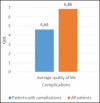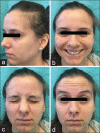Long-term Follow-up after Extracapsular Dissection of Parotid Pleomorphic Adenomas - A Retrospective Study
- PMID: 35265500
- PMCID: PMC8848710
- DOI: 10.4103/ams.ams_362_20
Long-term Follow-up after Extracapsular Dissection of Parotid Pleomorphic Adenomas - A Retrospective Study
Abstract
Introduction: Parotid pleomorphic adenoma (PPA) is the most common benign salivary gland neoplasm. Extracapsular dissection (ED) arose as a conservative surgical technique alternative to superficial parotidectomy to reduce complications.
Materials and methods: Patients who underwent ED for superficial, <3 cm, mobile parotid lumps (Quer I) between 2004 and 2008 were retrospectively analysed focusing on those with histological diagnosis of pleomorphic adenoma. A retrospective cohort study on 50 patients who accepted to undergo ultrasonography and clinical evaluation for at least 10 years since surgery was performed. Clinical data, surgical reports, and validated questionnaires for the assessment of complications, quality of life (QoL) and aesthetic satisfaction were analysed. Recurrence rate and complications after ED, with their QoL and aesthetic impact, were evaluated. Statistical analysis was performed setting α=0.05 as the level of significance.
Results: Low occurrence of complications related to ED was seen. Overall QoL after ED was very good (range 1-7, mean 6,86), due to low complications incidence of complications and their low severity, as assessed by patients through Parotidectomy Outcome Inventory-8 questionnaire. Overall aesthetic satisfaction was high (range 1-10, mean 9,78). Aesthetic satisfaction and QoL was statistically related to onset of complications (P = 0.02504 and P = 0.001859). Tumour localization and dimension was not statistically related to onset of complications (P = 0.8207 and 0.7586). After a mean follow-up of 12.5 years, no recurrences were detected.
Discussion: There is a lack of studies with a long-term follow-up after ED for the evaluation of recurrences and complications. Considering our results, the ED technique should be adopted as the first surgical approach for Quer I PPA without suspicion of malignancy.
Keywords: Extracapsular dissection; long-term follow-up; pleomorphic adenoma; quality of life; recurrences.
Copyright: © 2022 Annals of Maxillofacial Surgery.
Conflict of interest statement
There are no conflicts of interest.
Figures








Similar articles
-
Surgical approach to parotid pleomorphic adenoma: a 15-year retrospective cohort study.Br J Oral Maxillofac Surg. 2020 Jul;58(6):659-662. doi: 10.1016/j.bjoms.2020.03.020. Epub 2020 Apr 16. Br J Oral Maxillofac Surg. 2020. PMID: 32307129
-
Pleomorphic adenoma of the parotid: extracapsular dissection compared with superficial parotidectomy--a 10-year retrospective cohort study.ScientificWorldJournal. 2014;2014:564053. doi: 10.1155/2014/564053. Epub 2014 Oct 21. ScientificWorldJournal. 2014. PMID: 25401147 Free PMC article.
-
Surgical management of benign tumors of the parotid gland: extracapsular dissection versus superficial parotidectomy--our experience in 232 cases.J Oral Maxillofac Surg. 2013 Feb;71(2):410-3. doi: 10.1016/j.joms.2012.05.003. Epub 2012 Aug 9. J Oral Maxillofac Surg. 2013. PMID: 22884114
-
Postoperative complications after removal of pleomorphic adenoma from the parotid gland: A long-term follow up of 297 patients from 2002 to 2016 and a review of publications.Br J Oral Maxillofac Surg. 2019 Dec;57(10):998-1002. doi: 10.1016/j.bjoms.2019.08.008. Epub 2019 Sep 6. Br J Oral Maxillofac Surg. 2019. PMID: 31500918 Review.
-
Pleomorphic adenoma and benign parotid tumors: extracapsular dissection vs superficial parotidectomy--review of literature and meta-analysis.Oral Surg Oral Med Oral Pathol Oral Radiol. 2014 Jun;117(6):663-76. doi: 10.1016/j.oooo.2014.02.026. Epub 2014 Mar 12. Oral Surg Oral Med Oral Pathol Oral Radiol. 2014. PMID: 24767698 Review.
Cited by
-
Systematic Review and Case Report on the Surgical Management of Pleomorphic Adenomas: Lessons on Recurrence and Error Prevention.J Clin Med. 2025 Jun 26;14(13):4541. doi: 10.3390/jcm14134541. J Clin Med. 2025. PMID: 40648915 Free PMC article. Review.
References
-
- Bonavolontà P, Dell’Aversana Orabona G, Maglitto F, Abbate V, Committeri U, Salzano G, et al. Postoperative complications after removal of pleomorphic adenoma from the parotid gland: A long-term follow up of 297 patients from 2002 to 2016 and a review of publications. Br J Oral Maxillofac Surg. 2019;57:998–1002. - PubMed
-
- Colella G, Cannavale R, Chiodini P. Meta-analysis of surgical approaches to the treatment of parotid pleomorphic adenomas and recurrence rates. J Craniomaxillofac Surg. 2015;43:738–45. - PubMed
-
- Ungari C, Paparo F, Colangeli W, Iannetti G. Parotid glands tumours: Overview of a 10-year experience with 282 patients, focusing on 231 benign epithelial neoplasms. Eur Rev Med Pharmacol Sci. 2008;12:321–5. - PubMed
-
- Li C, Matthies L, Hou X, Knipfer C, Gosau M, Friedrich RE. A meta-analysis of the pros and cons of partial superficial parotidectomy versus superficial parotidectomy for the treatment of benign parotid neoplasms. J Craniomaxillofac Surg. 2020;48:590–8. - PubMed
LinkOut - more resources
Full Text Sources
